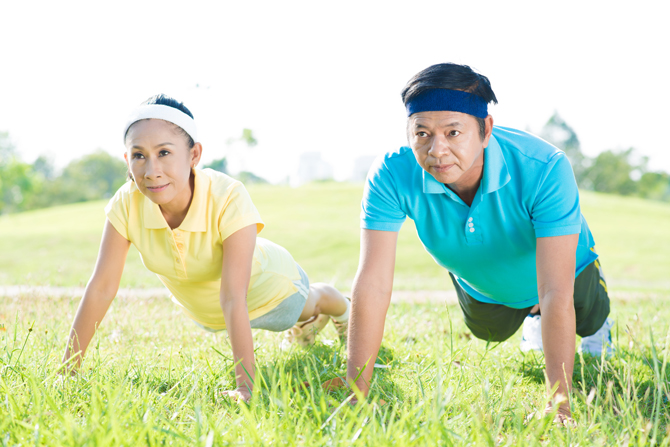
With osteophytes being a degenerative joint disease common in senior citizens, we have especially interviewed Dr Ho Sheung-tung, President of the Hong Kong Orthopaedic Association, on the causes of and preventive measures for the disease.
"Osteophytes, or bone spurs, are formed as a result of osteoarthritis. At the onset of osteoarthritis, the bones would form new tissues to repair damage in the cartilage, hence the formation of bone spurs," said Dr Ho. "This disease is more commonly seen in people in their middle-age or over, and its rate of occurrence increases with age. While women before menopause are more or less equally prone to osteophytes as men, they tend to show a higher risk of osteophytes after menopause."
Causes and Symptoms
Osteophytes are commonly formed in the spine, lower backbone, the cervical spine, knee joint, the metacarpal bone of the thumb, and the phalanges joints. "There are many causes of osteophytes, with the majority of the causes being of a primary nature that has no known causes, but are correlated to hereditary factors, joint wear and tear, and joint overload. Other common causes include congenital developmental anomalies, injury, bone infarction (avascular necrosis), and sequelae from infection in the joints and bones."
Patients afflicted with osteophytes would feel pain in the joints during activities and when tired, and the pain would only abate when the patients take abundant rest. Moreover, with the lack of activity during sleep time, patients with osteophytes would experience stiff joints upon waking up, and the patients' mobility is restricted because of the disease, such as the inability to squat. Joint deformities are also one of the symptoms of osteophytes, with the most common type being the o-shaped curvature of the legs, with the knees bent inwards."
Worsening of osteophytes could further jeopardise our health. "Take the spine for instance. The formation of osteophytes could narrow the foramen (openings in the spine that allow a part of nerve roots to leave the spine cord to go to other parts of the body), which in turn presses on the nerves and leads to numbness in the limbs, pain, lack of energy, and unsteady posture. Common sequelae include myelopathy in the cervical spine, lumbar spinal stenosis, and nerve root diseases such as sciatica," said Dr Ho. "It can be both debilitating and painful in cases where bone spurs or cartilage break off and float in the joint, or become stuck in the joint." However, pain or numbness in the joints is not a necessary indicator of osteophytes, as Dr Ho pointed out: "There are many causes of joint pain. On top of arthritis, the cause of joint pain could also be gout, septic arthritis or rheumatoid arthritis. It is therefore wise to consult a doctor instead of making your own judgement of the disease, so as not to cause septic arthritis as a result of delayed diagnosis or misdiagnosis, which in turn leads to permanent joint damage or sepsis."
Preventions and Treatments
"Obesity is the major reason for degenerative arthritis to worsen, which is why we advise senior citizens to monitor their weight to prevent problems such as overweight or abdominal obesity." The average body mass index (BMI) ranges between 18.5 and 22.9. The man's waist should measure no more than 90cm (35.4inches) while the woman's should be no more than 80cm (31.5inches). We would recommend senior citizens to exercise moderately every day, such as swimming or cycling, to protect the joints and improve mobility, relieve pain, and strengthen the muscle strength around the joints. Patients may use assistance tools such as walking stick, shopping cart, and long-armed clip to minimise the negative effects osteoarthritis has on their daily life. Hyaluronan injections, meanwhile, can alleviate pain for mid-stage knee osteoarthritis patients and delay the need for joint replacement surgery.
In terms of treatments for secondary osteoarthritis, the doctor will base treatment decisions on the causes. "In the case of osteoarthritis caused by injuries, for example, the patient would need precise and specific treatments for fracture, joint dislocation or relocation to effectively treat joint infection and lower the risk of osteoarthritis." In addition, senior citizens should avoid wear and tear of the joints, such as by maintaining the correct posture when lifting heavy objects or running, or by using the appropriate assistance tools to lessen the load on the lower backbone and knee joints.
"Medications are, to a certain extent, effective in killing pain, reducing inflammation, and improving joint function, and the more common types include paracetamol and non-steroidal anti-inflammatory drug (NSAIDs). In comparison, paracetamol is a safer option as NSAIDs are not for long-term usage due to possible complications such as peptic ulcer."
Surgery is normally recommended for severe cases, and it is divided into three types to serve three different purposes: prevention, pain relief, and ultimate replacement.
1. Preventive surgery: Osteotomy is done to correct joint deformities and recover joint strength.
2. Pain relief surgery: Arthroscopy is a surgical procedure where the arthroscope is used to remove broken cartilage in the joints.
3. Ultimate replacement surgery: More suitable for late-stage osteoarthritis, this type of surgery replaces half or whole joint.
With the sophistication and higher risk of success of modern-day knee or hip joint replacement surgeries, the new, artificial joint surfaces in over 95% of patients can be used for 10 years.
While non-prescription medicines for wellness exist in abundance, Dr Ho regards glucosamine and chondroitin as the safer options, with the former providing certain degree of pain-killing effect as glucosamine is a major component of joint cartilage. However, it is always best to consult the doctor as many of these non-prescription medicines are not stringently medically tested, and an overdose of which could increase the risk of diabetes (patients with shellfish allergy need to be additionally careful when taking these medicines).
Special Thanks:
Dr Ho Sheung-tung, President of the Hong Kong Orthopaedic Association